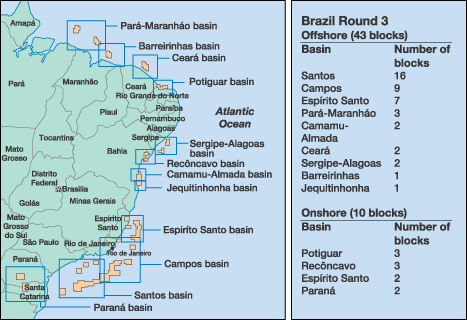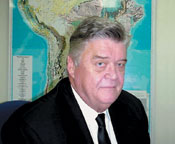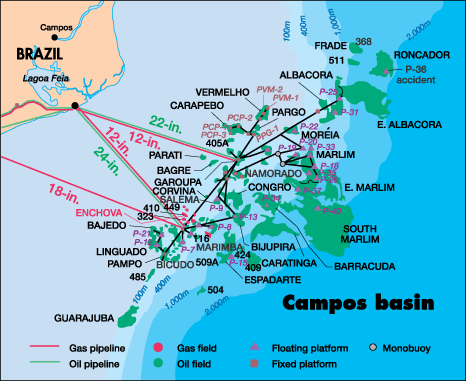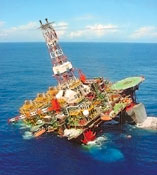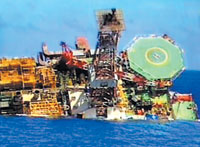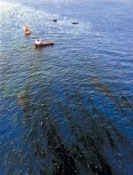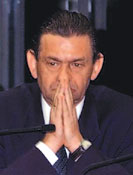Brazil sustains period of expansion
REGIONAL FOCUS: BRAZILBrazil sustains period of expansionDespite recent setbacks, Brazil’s E&P sector continues to thrive. Activity is buoyed by good, plentiful discoveries, the widening participation of foreign operators, large field development projects and an extremely supportive governmentKurt S. Abraham, Managing/International Editor
Some of the high points include the overwhelming success of the second licensing round; a string of new discoveries; the announcement last fall of a restructuring plan within Petrobrás to heighten its efficiency; and the naming of Jose Jorge de Vasconcelos Lima in March as the country’s new Mines and Energy Minister. On the negative side, there has been considerable squabbling among political parties in the government over the future of Petrobrás, as well as the entire upstream industry. Petrobrás also has endured an embarrassing string of accidents, capped by the tragic, fatal explosions onboard the P-36 floating production vessel (see sidebar story) that caused the semisubmersible to sink. Ironically, the P-36 accident came just two days after Vasconcelos Lima was sworn in as Mines and Energy Minister. National Policy/Lease Sales As Brazil entered the 1990s, Petrobrás struggled to develop all its discovered oil and gas reserves with limited investment funds. As the situation became more acute in the mid-1990s, the Brazilian government finally took the bold step of ending the state firm’s monopoly of oil and gas activity. Under a careful, gradual plan, foreign operators were allowed to enter the country’s upstream sector. Officials also created a new regulatory agency, National Petroleum Agency (ANP), to oversee control of the sector, replacing supervision previously supplied by Petrobrás. The cornerstone of ANP’s opening of E&P activity to foreign participation has been a system of licensing rounds. To date, two rounds have been held. These occurred in June 1999 and June 2000, with 27 and 23 blocks offered, respectively. In Round 1, 23 of the 27 blocks offered were offshore, including 12 tracts in the Campos and Santos basins. Among a field of 38 prospective bidders, 10 multinationals offered $182 million for rights to 12 blocks. By contrast, Round 2 was far more successful. The 23 blocks offered included 13 tracts offshore (seven in deep water). Of these, only two areas were not sold. Companies paid $264 million for the Round 2 concessions. A third round is scheduled this month, with 53 blocks slated for bidding, Fig. 1. Many of the third-round blocks are deepwater tracts, although a smaller proportion is in the Campos basin (compared to the earlier rounds). ANP has set a $150,000 minimum price for the 31 deepwater areas, identified as "A" blocks. The minimum price for 14 shallow-water and onshore areas ("B" blocks) is $100,000, and the beginning rate for another eight onshore tracts ("C" blocks) is $50,000.
Bidding among foreign firms and domestic companies is expected to be spirited. Companies that entered the E&P sector via the first two rounds or through joint ventures and farm-ins with Petrobrás included Agip, Amerada-Hess, Chevron, Coastal (now El Paso Energy), Devon Energy, Enterprise Oil, ExxonMobil, Kerr-McGee, PanCanadian Petroleum, Repsol-YPF, Shell, Texaco, TotalFinaElf and Unocal. Ironically, Petrobrás made a strong showing in both rounds, obtaining numerous blocks for itself. In Round 2, Petrobrás secured eight of the 10 areas for which it bid. The state company and its associated groups accounted for nearly three-quarters of the money raised from the sale. Brazilian firm Ranier Engineering also did well, bidding alone for four onshore oil fields. When one considers the acreage that ANP held back from bidding, as well as the tracts that Petrobrás won in Rounds 1 and 2, the state firm in effect continues to hold rights to the most promising fields and prospects. This is particularly true for the Campos basin. There is no doubt that opening offshore tracts to foreign operators should increase the discovery rate for new deepwater and ultra-deepwater fields. Nevertheless, some foreign firms have expressed reluctance to enter the Brazilian process. The primary reason involves conditions prescribed by the government under the existing petroleum fiscal regime. These include a special petroleum tax, royalty arrangements and inclusion of several front-end taxes.
Exploration More than 30 oil fields have been discovered in the shallow and deep waters of the prolific Campos basin along Brazil’s southeastern coast, Fig. 2. Supporting the theory that the South American and African tectonic plates were once connected, the geology of Campos basin is very similar to that of the Angolan basin.
Seven deepwater fields have achieved giant status, and a major portion of their reserves are in water depths greater than 1,000 m (3,280 ft). According to ANP, Campos basin offshore fields and their onshore extensions collectively hold proven, recoverable oil / condensate reserves of 7 to 8 billion bbl. Petrobrás last September signed a farm-out agreement with Coplex, now a subsidiary of Canada’s Naftex Energy. The contract calls for further exploration of 1,981-sq-mi Block BS-3 in the Santos basin, as well as development of the tract’s Coral and Estrela do Mar fields, about 100 mi offshore. Discoveries. There has been a steady stream of new finds during the last 10 months. Shell said last September that it hit hydrocarbons in its first offshore well drilled in Block BM-C-10 of the Campos basin. Initial indications were found in the upper section of the 1SHEL-1-ESS well. Shell proceeded to drill a deeper section and conduct an analysis of what was rumored to be a sizeable oil find. However, confirmation and details have not been provided. Meanwhile, in October 2000, Petrobrás drilled a large gas find offshore in Block BCAM-40 of the Camamu basin. The 1-BRSA-14-BAS reportedly tapped a reservoir of more than 700 Bcf of gas in 125 ft of water, 16 mi off the coast of Bahia. The well was drilled to a 5,997-ft TD. Pay was found at depths of 3,871 and 4,626 ft, in the Agua Grande and Sergi formations, respectively. Petrobrás stated that the field should produce between 70 MMcfgd and 100 MMcfgd, when it is developed. Amerada Hess struck oil and gas last November in BS-2A on Block BS-2. Although details were not disclosed, the firm said that it had aimed at the target with the best chances of finding hydrocarbons, rather than just test the largest structure. On the basis of BS-2A’s results, Amerada Hess began drilling on its BC-8 block during that same month. The company holds a 32% stake in Block BS-2 by virtue of a farm-out by Petrobrás in 1998. The latter firm retains a 40% interest. Such joint ventures have become commonly known as "blue blocks," and they were farmed out before Brazil’s first licensing round in 1999. Most permits on these tracts are set to expire in August 2001. Meanwhile, on another blue block, Coastal Corp. (now El Paso Energy) hit an onshore gas find last November in the BPAR-10 at a depth of 9,840 ft. The 1-Rio Vorá-2P-PR encountered gas in four separate sands of the Permian Rio Bonito formation. Further drilling to a final TD of 12,30 ft was conducted, and additional testing was scheduled. The site is a few miles west of the city of Pitanga in the state of Paraná. In December 2000, Petrobrás announced an offshore oil find in the Campos basin, at a water depth of 2,243 m (7,359 ft). The discovery tested 3,000 bpd of 35°API oil. This is said to be the company’s first find in water depths of more than 2,000 m. Petrobrás planned to drill additional wells to determine whether the find is commercial. The firm also began the new year in good fashion by striking oil in early January at the 1-BRSA-33-ESS well of the Campos basin. Oil was found in an interval between 9,232 and 9,514 ft. Water depth at the tract is 4,085 ft. Further evaluation was underway. This was followed last month by a find of 35°API oil in deepwater Block BS-500 of the Santos basin, at a depth 0f 4,920 ft. In April 2001, Devon Energy and Repsol-YPF announced discoveries on their respective tracts. Devon said that indications of oil were found in the BPOT-2 Block, in shallow waters offshore northeastern Bahia state. Repsol-YPF reported to ANP, that it struck gas in the BES-3 shallow-water tract offshore Espirito Santo state. Meanwhile, TotalFinaElf began drilling its first well in the BC-2 Block during February. The company supposedly struck a discovery with the well, but no details have been forthcoming. Early this year, British Gas was finishing a seismic shoot over its B-11 Block in the Santos basin. ExxonMobil also was drilling its Pelotas basin prospect in Block BP-1. Texaco also began drilling the $1.5-billion Frade prospect early this year in nearly 5,000 ft of water. During second-half 2001, Unocal is to begin an $80-million program in the BC-9 Block of Potiguar basin that contains Pescada Arabaiana field. ENI will hold off operations until 2002, when it has plans for drilling in Blocks BM-POT-1, BM-S-4, BM-C-3 and BM-C-4. Development Several offshore field development projects are underway, not all of them operated by Petrobrás. Enterprise Oil awarded a $55-million contract last October for a drilling program as part of the Bijupirá-Salema field development project. The program is expected to begin in mid-2001 and last two years, with 16 wells provisionally planned. This would include seven production wells and four water injectors at Bijupirá, plus three production wells and two water injectors at Salema. The fields are adjacent to each other in the Campos basin, about 55 mi from Cabo de Sao Tome, in water depths ranging from 1,575 to 2,887 ft. Enterprise also awarded a $270-million contract in April 2001 for provision of an FPSO and subsea equipment. The FPSO will process up to 70,000 bopd and store as much as 1 MMbbl of oil. Last November, Petrobrás signed a financing deal for Albacora oil field. The $170-million deal is with Japanese firms Nissho Iwai Corp. and INPEX, and it finances completion of production development at Albacora. The field is in the Campos basin, offshore the state of Rio de Janeiro. As Albacora Phase II is completed, the field’s output will rise to 150,000 bopd from 50,000 bopd. In January 2001, Petrobrás also received two additional vessels for its Marlim Sul field development. The P-40 floating production platform and P-38 FSO arrived at Guanabara Bay for additional equipment installation before heading to the field site in the Campos basin. Together, the vessels will comprise the first of four so-called production system modules at Marlim Sul. The P-40 can process up to 150,000 bopd and export a maximum of 212 MMcfgd. The first module should go onstream in July and reach peak output in November. When all four modules are complete, Marlim Sul should hit peak output of 360,000 bopd in 2007. Drilling levels. The entry of foreign operators, coupled with much-higher oil prices, has improved drilling activity drastically throughout Brazil. Wells drilled had fallen to only 240 (for 1.5 million ft) in 1999, from 321 in 1998 (for 1.8 million ft). However, ANP said that drilling rebounded 17% last year, to 281 wells. The outlook this year is for 21% improvement, to 341 wells. Offshore activity is expected to jump 56% higher, to 140 wells. Production Petrobrás continues to break its own oil production records with impressive regularity. Last September, Brazilian output surpassed 1.34 million bopd, led by an increase to 508,000 bopd at Petrobrás’ Marlim field. The company also began exports of Marlim’s crude last year. At Marlim, where water depths range from 2,145 to 3,465 ft, there are 86 wells in operation, controlled from seven production platforms. The field first went onstream from an early output scheme in March 1991. Marlim supplies about 50% of Campos basin output and 38% of Brazil’s total oil production. As a whole, the basin began producing more than 1 million bopd in July 2000, representing 78% of national output. On December 30, 2000, Petrobrás shattered its September record by establishing a new one-day output mark of 1,531,365 bopd. The firm also set a monthly average production record in December of 1,458,000 bopd. Credit for the new records was given to additional new deepwater wells at Roncador and Marlim fields. For 2000, the daily output averaged 1.271 MMbopd. Petrobrás produces nearly all of Brazil’s oil, although other sources have begun to establish a small presence. Union Pacific Resources (now Anadarko Petroleum) was the first private operator, producing several hundred bpd onshore. Then, in July 2000, Santa Fe Snyder (now Devon Energy) became the first private offshore operator. The firm’s Carauna field went onstream in the Potiguar basin, producing initially from a single well (CES-124) at about 1,000 bpd of 23°API crude. The company planned to re-enter three more wells and drill two additional new wells as part of a pilot production program. If all goes well, Carauna field will be fully developed by 2004, with peak output of more than 30,000 bopd. ANP last October prequalified 56 companies to bid on mature fields relinquished by Petrobrás. The firms included 40 Brazilian and 16 foreign companies. Nine firms were disqualified, because they had either failed to submit complete documentation, did not have sufficient net worth or presented excessive indebtedness. A two-day auction of 11 separate blocks containing 73 mature oil fields was held on May 10 – 11. Unfortunately, only two blocks received bids. The winning bids were submitted by the W. Washington Company for Block BA-1 ($8.1 million, a 53% premium) and Ranier Engineering for Block AL-1 ($6.7 million). All the various good news occurring in Brazil’s production sector unfortunately has been somewhat overshadowed by a string of accidents during the last 12 months. In July 2000, Petrobrás was fined $28 million by the Paraná state government for inadvertently allowing more than 25,000 bbl of crude to escape. The spillage took place at a rupture in a pipeline at the Getulio Vargas refinery, and some of the crude found its way into the Iguazu River. Then, in March 2001, the much-publicized explosions occurred on Petrobrás’ largest floating production platform, the P-36 (see sidebar story) The accident killed 11 people and caused the vessel to sink, resulting in the spillage of more than 7,500 bbl of diesel oil. Less than a month later, yet another oil spill occurred, again offshore. At the P-7 production platform in Bicudo field in the Campos basin, more than 160 bbl of crude oozed from a connection in the production piping while the BI-12 well was undergoing an early-morning test. Petrobrás temporarily halted production of 15,000 bopd from Bicudo, while the spill was cleaned up and repairs were made to the piping involved. If these problems were not enough, ANP last December
announced that it was preparing a gas well audit for the Campos basin, to see whether or not Petrobrás
has been "wasting" natural gas through flaring. The audit reportedly was completed in February, but
no results have been announced. ANP has the power to punish Petrobrás for flaring, if it so decides.
According to published reports, the firm could be flaring as much as 210 MMcfgd, or nearly one-third of
Brazilian gas demand. The company already has had to pay a 10% royalty on the production cost for about 140
MMcfgd that it flares. There have been allegations that the gas was flared to boost the demand for imports of
Bolivian gas, thereby ensuring the feasibility of the Bolivia-Brazil pipeline.
|
- Applying ultra-deep LWD resistivity technology successfully in a SAGD operation (May 2019)
- Adoption of wireless intelligent completions advances (May 2019)
- Majors double down as takeaway crunch eases (April 2019)
- What’s new in well logging and formation evaluation (April 2019)
- Qualification of a 20,000-psi subsea BOP: A collaborative approach (February 2019)
- ConocoPhillips’ Greg Leveille sees rapid trajectory of technical advancement continuing (February 2019)

